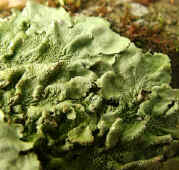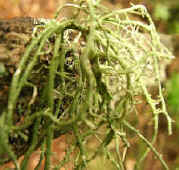|
 |
 |
Lichens
|
 |
 |
What are Lichens?
Lichens present a very intriguing problem for people whose job is to name different kinds of organisms. This is because a lichen is not a separate organism in the sense of being one type of individual. It is actually a close partnership between a fungus and an alga. (Algae are very simple plants). The two types of organisms in the partnership are so closely interwoven that they appear as a single individual. This individual looks entirely different to either of the partner organisms making up the structure. Lichens are distinctive and they form many different, recognizable types. Many of these have been given specific names of their own, despite the fact that each lichen is already a mixture of different species. There are more than 1,700 species of lichen in Britain. Approximately 18,000 species of lichen have been described and identified worldwide. The algal partners in lichens can be found living on their own in nature, as free-living species in their own right. The fungal partners in British lichens are recognizable Ascomycetes or Basidiomycetes. However, they have come to need the right kind of algal partner in order to survive. Unlike other fungi or indeed their algal partner, they cannot survive on their own. Of the more than 1500 *genera of algae worldwide, relatively few make suitable lichen partners. In Britain, only three genera, Trebouxia, Trentepohlia and Nostoc are common fungal partners. Interestingly, the same alga can combine with different fungi to produce entirely different lichens. The same fungus can also form different lichens depending on the type of alga which it associates with. Most lichens contain only one kind of alga, but some may contain two. Identifying the type of alga in a lichen may be difficult, as they frequently look different to the free-living forms. The fungal partner forms the main body of the lichen, with the algal cells either scattered among the fungal hyphae, or arranged in a layer just below the upper surface of the lichen. Lichens colonize some of the most inhospitable habitats on earth. They can survive in extremely cold areas such as on high mountains and in regions such as the arctic. They may be virtually the only plant form surviving in some of these areas and can be vitally important sources of food for animals. They are also found throughout less extreme climates, inhabiting just about any solid surface. This can range from rocks on sea shores, to walls, trees and concrete. A few are unattached and blow about freely. Lichens are so enormously successful and widespread because of their unusual partnership. The algal cells, through the process of photosynthesis, provide the fungus with some of the organic nutrients which it needs. In lichens where the partner is a species of Nostoc, organic nitrogen is also supplied to the fungus, because Nostoc is able to fix atmospheric nitrogen. In return, the water, nutrients and gases absorbed from the environment by the fungus are shared with the algae. The fungus also plays a vital role in providing a physical structure to shelter the algae from excess sunlight and in particular, water loss. There is uncertainty over the exact nature of the relationship between the fungus and the alga. Some people think the fungus may be a type of weak parasite, which doesn't kill all of the algal cells or, that it keeps the alga imprisoned as a kind of slave. Alternatively, it may be a type of relationship called a 'symbiosis' where both partners benefit. Whatever the exact nature of the relationship, it undoubtedly results in an 'organism' which is capable of surviving in places where neither the fungal partner, nor the algal one, could survive on their own. Lichens have a variety of different growth forms. The simplest lichens are crusts of loosley mixed fungal hyphae and algae. Others are more complex, with leafy or shrubby forms like miniature trees, also having specialised structures to attach them to a surface.
|
|
 |
 |
| Crustose encrusting lichens |
Foliose leafy lichens |
Fruticose shrubby lichens |
| Crustose (or Crustaceous) lichens
are, as their name suggests, encrusting forms which spread over and into the surface of
their habitat. They cannot be removed from the surface without crumbling away. Foliose lichens are lichens with leafy lobes, which spread out in a horizontal layer over the surface. They are attached by root-like threads and can be easily removed with a knife. Fruticose lichens are shrubby forms with many branches. They can be removed from the surface by hand. There are many gradations of form in between these three main groups and a lichen may not always fit clearly into one or other of these artificial categories. Lichens reproduce either by tiny parts of the lichen breaking off and growing somewhere else, or by the fungal partner producing spores. Lichens may have powdery masses on their surface. These are the tiny bits of the lichen body which will be shed to form new lichens. The individual bits are called soredia and they contain both the fungus and the algal partner together. In most cases, fungal spores are either produced in apothecia or perithecia on the surface of the lichen. The spores come only from the fungal partner and do not contain any algal cells. They may germinate after being shed from the fruiting body, but they will only be able to form a new lichen if they happen to make contact with a suitable algal partner. Without the alga, the germinating spore will die, as the fungus cannot survive on its own. The fruiting bodies of most lichens are unusual in that they may continue to produce spores at intervals for several years. The fruiting structures of individual fungi in contrast usually last for a relatively short period. Lichens grow relatively slowly. The actual growth rate depends both on the species and on the environmental conditions around it. The smaller encrusting lichens may grow as little as 1mm a year! Larger forms may grow up to 1cm per year. This slow growth rate has been used to develop a method of dating surfaces on which lichens are growing. The method, known as lichenometry, has been used in places such as the arctic, where lichens grow very slowly and can live for very long times. The method works by using a series of photographs over a period of time, to work out the growth rate of the particular lichen. From the size of the lichen, it is then possible to calculate how long it has been growing there. Using this method, some individual lichen colonies have been estimated to be 9000 years old. If this is so, then these particular lichens may well have been alive while people were still in the Stone Age and woolly mammoths roamed! Lichens absorb water and minerals from rainwater and directly from the atmosphere, over their entire surface area. This makes them extremely sensitive to atmospheric pollution. As a result, there are usually very few lichens around industrial centres and towns. Different lichen species vary in their tolerance to pollution and therefore make very good biological indicators of levels of atmospheric pollution. A walk around your local churchyard can often reveal a lot about air quality in your area. Churchyards are usually relatively undisturbed areas, with stone headstones which provide a good substrate for lichens. A good look at these lichens will give an indication of how good the air quality is locally. Lichens have had a wide variety of uses over the ages. Before the advent of modern dyes they were extremely important sources of dyes for clothing. Different lichens yielded different dye colours and they could be mixed to produce a wide variety of colours. Lichens also have an interesting chemistry and produce a large number of acids, many of them found only in lichens. The litmus dye used so widely as an acid/alkaline indicator in chemistry comes from lichens. Some species also have antibiotic properties. Some of the lichen acids are utilized in drugs that can be more effective than penicillin. One of the more bizarre uses of lichens from the past is as packing material for ancient Egyptian mummies! |
| *A genus (genera, if there are more than one) is a group of different species which are very similar to each other. |
Lichen species list for the Woodland Education Centre